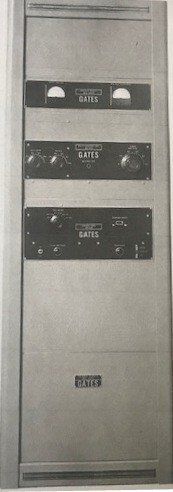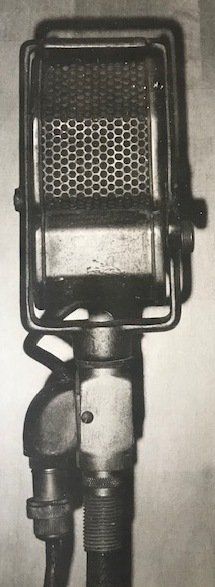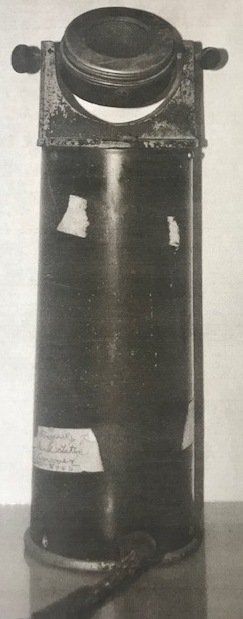The Gates Radio Company, 1936 to 1939

First 250-watt broadcast transmitter manufactured by Gates Radio and sold to station WJMS in Ironwood, Michigan, for $2,750 in 1936. A 1938 restored 250-watt A Gates transmitter is on display at the GatesAir office and factory at 30th and Wisman Lane. (Photo courtesy of the author)
Having gone through the challenging year of 1935 when the Gates Radio Company almost closed, Parker Gates was now determined to move the company forward. On May 25, 1936, Barbara Ann Gates, the first child of Mildred and Parker Gates, was born. Parker Gates was now even more motivated to make Gates Radio a success.
One of the first projects was to manufacture a quality console. The console would take microphones, turntables, and outside circuits for indoor and outdoor events and mix them into the one circuit for broadcasting. The first Gates console sold for $650. There was one competitor, Collins Radio in Cedar Rapids, Iowa.
The next big step was to develop an AM (Amplitude Modulation) radio transmitter, arguably the most important piece of equipment in a radio station. A radio transmitter produces electromagnetic waves that radiate via a cable to an antenna, usually on top of the station's building. The principal transmitter and antenna tower is located at a remote location connected to the studio by use of a studio-to-transmitter radio link. Buried ground wires go out from the antenna for several hundred feet and the electromagnetic wave it creates puts the radio station on the air. Radio receivers within the range of this signal convert it back to an audio signal, to be heard by any listener.
To prepare for this, Gates traveled the country and serviced transmitters at regional stations to gather the feel and footwork. He then hired an engineer versed in radio broadcasting station transmitter design.
In 1936, the first 250-watt broadcast transmitter was manufactured by Gates Radio and sold to station WJMS in Ironwood, Michigan, for $2,750. That was one-third the price of Gates’s closest competitor, whose 100-watt model was priced at $8,400. Parker said Gates Radio made a courageous move because RCA and Western Electric had strong patents in the field. But the Gates transmitter had new design elements, lowering the cost of what was considered by those in the business to be a better transmitter.
Parker said he gave WJMS a letter stating he would defend the buyer in court in the event RCA and Western Electric sued. David Sarnoff, president of RCA, wrote threatening letters and Gates responded, “Meet us in court.” RCA backed off. As Gates told the story, Sarnoff considered Gates Radio just a “Podunk” company somewhere in the Midwest but not much of a threat. Sarnoff’s engineers warned him to do something.
Sarnoff contacted the Federal Communications Commission, and the FCC informed Gates Radio it must license this transmitter. Gates completed the application and Gates Radio was licensed to make “heavy broadcasting equipment including transmitters.” A few days later the FCC informed Gates Radio they must pay three percent of every sale on their 250-watt transmitter to RCA, and two percent to Western Electric. “So,” Gates said, “David Sarnoff played his hand.”
Gates Radio also became well-known for the development of microphones. An early Model “G” Bullet desk-height condenser microphone was popular, and hundreds were sold. President Franklin D. Roosevelt spoke into Gates’s Model “M” Velocity standing microphone, featured in the 1936-37 Gates Catalog, at the dedication on September 4, 1936, of the new bridge over the Mississippi River at Hannibal, Missouri. Allen Oakley, then a young Herald-Whig staff reporter and photographer and later editor of the paper, took photographs of the event. Gates Radio was hired to supply public address equipment for the dedication. Gates and employee Paul Tourney loaded sound amplifying equipment and speakers into the Gates field truck, drove to Hannibal and set up the sound equipment. Large speakers were placed on high wooden platforms.
A September 4, 1936, Herald-Whig story stated that more than 30,000 people attended the event. “One saw a sea of faces that stretched across the areaway between the intersecting roads and down every side street, with eyes turned toward the speakers’ platform. The valley below formed a natural amphitheater, and huge (Gates) amplifiers carried the voices of the speakers clearly for several blocks.”
A photograph shows Roosevelt speaking into the Gates microphone. “Roosevelt was up on a makeshift stage, and wires were all over the place,” Gates said. “We got the sound equipment all set up and I prayed that it would work. It did, and Mr. Roosevelt shook my hand and thanked me.”
Next came the development of the complete radio studio package. “No one, including RCA,” Gates said, “was putting together a complete studio package, so we came up with the idea of putting together everything you would need or want in a radio station. It was called the Broadcast Equipment package and would include the transmitter, console, microphones, turntable, antenna tower, everything. The package would cost, depending on the options, between $10,000 and $20,000. The studio package was a big success, and RCA and other companies scrambled to put together their competing packages.”
Gates hired more self-taught engineers in 1938, and the company grew to thirty-five employees. “We had outgrown the 115 North Fourth Street building,” Gates stated, “and in 1939 the company purchased a new plant at 220 Hampshire Street, a one-story, modern saw-tooth building with approximately 12,000 square feet of floor space, and the line was expanded to 1,000-watt transmitters and many additional products for both radio and communications.”
Gates Radio Company had now been in existence for 17 years. Parker Gates was 32 years old, and Mildred and Parker’s second daughter, Janet, was born.
There were indications war was on the horizon. Having the foresight and good fortune to now be in a new building with expanded factory space, Gates Radio was well equipped to face the difficult war years ahead.
Janet Gates Conover and her husband, Joe, are life members of the Historical Society of Quincy and Adams County. This article is based on Gates Radio Company research and documents, interviews with her father, Parker Gates, and family oral history and letters.
Sources
Gates, Parker. Brief History of Gates Radio Co., Year 1936, 1937, 1938, 1933, 1939. Quincy, IL. 1957.
Gates, Parker. Interviews. Janet Gates Conover, 1975 –1986.
Gates, Parker. Letters. Janet Gates Conover.
Gates Radio and Supply Company Catalogs, 1936-1939.
“Hannibal Has Biggest Crowd in Its History; President City’s Guest.” Quincy Herald-Whig, September 4, 1936. 1, 5.
“History of the Gates Radio Company.” 1936, 1937, 1938, 1939. Published in-house.
“How Radio Works.” Georgia State University Library exhibits. https://exhibits.library.gsu.edu

Head of Model "M" Velocity standing microphone used when Franklin Roosevelt spoke at dedication of bridge over Mississippi River in Hannibal, Missouri, September 4, 1936. (Photo courtesy of the author)

Popular Gates Model "G" Bullet condenser microphone. Hundreds were sold. (Photo courtesy of the author)






